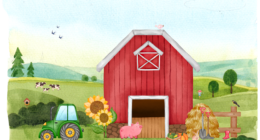by Ruth Conniff and Tyler Buchanan, Ohio Capital Journal
All in all, 2019 was a terrible year for farmers across the Midwest and so far 2020 doesn’t look much better.
Bad weather, trade wars and low prices due to oversupply all contributed to the grim economic news, even before the COVID-19 pandemic began wreaking havoc with export markets.
“Agriculture has been in a pretty strong downturn for a lot of commodities,” says Paul Mitchell, a professor of agriculture and applied economics at the University of Wisconsin. “Oversupply and low prices are a problem for corn, soy and dairy,” Mitchell adds. “Trade wars only exacerbated the problem. And 2019 was a horrible production year.”
The United States set a stunning record last year of 20 million acres of “prevented planting” on land that was unusable for crop production because of historic flooding and record rainfall, much of it in the corn belt. That was more than double the previous record of 10 million acres set in 2011.
In Ohio, corn and soybean harvests were down 22% and 15% respectively from 2018 to 2019. Much of this can be blamed on widespread flooding throughout the early summer months. Nearly half of Ohio’s 88 counties received a “disaster” designation from the U.S. Department of Agriculture, making local farmers eligible for financial assistance. Crop insurance payments to the farmers whose fields were destroyed, along with $14.3 billion in direct payments to farmers through the federal Market Facilitation Program (to make up for lost sales because of trade wars), propped up farm income, which otherwise would have been down from 2018 — another bad year.
“While this aid is appreciated, I fear I speak for the bulk of our nation’s farmers when I say it may be too little, too late,” Wisconsin Farmers Union President Darin Von Ruden said in a statement last August, after the Trump administration released its emergency aid package for farmers affected by the trade wars with China and other nations. “The USDA aid package is a band-aid on the gaping wound of unstable markets,” Von Ruden added, calling instead for efforts to work toward building an agricultural economy that is embedded in local and regional communities rather than depending on exports.
Get big or get out
An aerial view from a drone shows a combine being used to harvest the soybeans. (Photo by Joe Raedle/Getty Images)
Experts agree that American farmers are suffering because of the way the system is geared toward more and more production and lower and lower prices.
Even after last year’s low yield, “basically, the (reduced) crop that was planted and harvested produced enough corn to meet demand at a fairly low price,” Mitchell says. “Same for soybeans. I cannot imagine if all those acres had been planted and yields had been good. Prices would have been very low.”
 In other words, farmers do poorly when they don’t produce much, and when they produce a lot, prices go down, which also hurts them. For every dollar American consumers spend on food, U.S. farmers and ranchers earn 14.6 cents according to a 2019 USDA report — a new low since the USDA began keeping track of the statistic in 1993.
In other words, farmers do poorly when they don’t produce much, and when they produce a lot, prices go down, which also hurts them. For every dollar American consumers spend on food, U.S. farmers and ranchers earn 14.6 cents according to a 2019 USDA report — a new low since the USDA began keeping track of the statistic in 1993.
“The market tells people, ‘We don’t need as much as you’re producing,’” Mitchell says. So American farmers have become heavily dependent on export markets to unload all their extra product. Right now, that makes their situation particularly dicey.
“Apple will never make more iPhones than they can sell for $1,000, or whatever their price point is. They’re highly coordinated,” says Mark Stephenson, director of dairy policy analysis at the University of Wisconsin’s College of Agriculture and Life Sciences. The same is not true for farmers: “because they’re uncoordinated, they overproduce.”
But overproduction is also longstanding U.S. policy, ever since President Nixon’s Secretary of Agriculture Earl Butz told farmers to “get big or get out,” rejecting the New Deal supply management policies that protected farmers and kept a floor on prices, and moving the country toward a vision of agribusiness-friendly cheap, mass production.
At the World Dairy Expo in Wisconsin last year, Trump’s Secretary of Agriculture Sonny Perdue told the state’s struggling dairy farmers, “We are a country so blessed that we have to depend on foreign markets because we are so productive.” Asked about the future of the dairy business in Wisconsin, the state that leads the nation in farm bankruptcies, with years of low prices driving family farms out of business, Perdue channeled Butz: “In America the big get bigger and the small go out. I don’t think in America we, for any small business, we have a guaranteed income or guaranteed profitability.”
The wrong kind of farming
“He’s supporting all the wrong kinds of farming in my book,” says retired organic dairy farmer Jim Goodman, who recently gave up his small herd. “The trend has been to produce more and more with no one asking how much might be too much.” (Goodman has written for the Examiner about the problems faced by farmers.) “The price consumers pay at the store has nothing to do with what farmers are earning,” Goodman adds. A handful of large food companies reap the profits, while farmers continue to suffer from low prices.
A recent report by the Center for American Progress backs up his point: “Direct farmer-to-consumer sales make up a negligible portion of farmers’ sales; most farmers’ real customers are the processors, grain traders, and marketers that buy raw goods from farmers and then grade, package, process, manufacture, and distribute them as food products.”
The report also notes that “almost every step of America’s food supply chain has grown more concentrated in the past few decades.” Pesticides, farm equipment, seed suppliers, processors and commodity buyers have shrunk to a handful of big companies thanks to mergers and acquisitions and increasing corporate consolidation, leaving “relatively small farms and ranches vulnerable to exploitation at the hands of the oligopolies with which they do business.”
Nestle, the world’s largest food company, reported that its 2019 net profits rose to $12.9 billion according to a Dow Jones Newswire report. “Profitability improved again and reached our guided range one year ahead of plan,” said Chief Executive Mark Schneider.
Dairy industry struggles
Dean Foods Inc., the largest dairy company in the United States, filed for bankruptcy in 2019, citing high debt and diminished consumer demand for milk as dairy alternatives like oat milk become more popular.
Nowhere has the farm crisis hit harder than in Wisconsin, where, for the last several years one to two dairy farms have been going out of business each day.
“We clearly are in a big crisis and that’s easily seen by the attrition rate on farms over the last three years,” says UW dairy expert Stephenson. “But this is because of about five years of suppressed prices,” he adds. “It’s not that the price drop is so steep. It’s that it’s so persistent. If you look back in time, farms carried a lot more debt and banks were willing to lend at higher rates.” Farms could get through a downturn by putting off purchases and waiting for a better year. “This has just been too low for too long.”
What’s startling is that even as the number of dairy herds has been cut in half over the last 16 years — dropping from 15,838 in March of 2004 to 7,258 in March of 2020, according to the state agriculture department — the number of cows has stayed steady at about 1.2 million. There are just fewer herds.
“I read about a farm in Texas that’s milking 100,000 cows. If you extrapolate, we’d only need 90 farms that size to meet the demand for the entire U.S.” Goodman says. “Is that what we want? That’s just insane.”
What’s the solution?
The National Farmers Union’s “Farmer’s Bill of Rights” endorsed by U.S. Sens. Bernie Sanders of Vermont and Elizabeth Warren of Massachusetts, demands big, structural change in the whole U.S. food system, including a fair income for farmers, more competition and the break-up of huge agribusiness monopolies, local supply stores and processing facilities, and the “right to repair” farm equipment banning contracts that require farmers to take tractors and other equipment back to the dealer and pay for expensive repairs.
Goodman supports the Bill of Rights, as well as the idea of a Canadian-style production management system. “If we had programs similar to the New Deal — production limits and floor prices, farmers might stand a chance of making a decent living again,” he says.
Mitchell hesitates to go that far. “It’s very complicated,” he says, noting that many farmers are conservative and don’t like the idea of heavy-handed government regulation.
Still, times are tough for big and small producers alike, and there may be more openness to some sort of supply control model than there was in the past, he says: “Hey, they’re talking about it.”
“I don’t think we’ll ever go as far as a Canadian system,” says UW dairy expert Stephenson. “It’s very strict, you have a piece of paper saying you can only sell a certain amount. And there are strict import controls, too.”
Still, Stephenson believes there could be ”a system of supply control, one without strict limits, but you pay less if you go above and beyond a suggested amount in the market.”
“We have to either cut back production or enhance demand,” says Mitchell, who recently attended a dairy innovation conference that was all about developing new products that appeal to a public that has a declining appetite for milk. “It’s the same with corn and soy — finding new uses for it,” he says. “ Five or six years ago all the talk was about biodegradable plastic made out of corn.”
“The standard response is to find more uses for products,” he adds.
For farmers in recent years, if it’s not one thing wrong it’s another. In one example from Ohio, farmers and state officials alike determined a solution to a major problem: phosphorus runoff leading to algal blooms up in Lake Erie. The state established a new program, H2Ohio, which is offering $30 million in funding to Buckeye State farmers toward reducing nutrient runoff. This was seen as a win-win, allowing for better profits and a cleaner environment.
The COVID-19 public health crisis is delaying the program from taking shape. Local offices supplying the funding applications have closed due to the virus, pushing things back for at least several months.
Suicide prevention
There is no more obvious sign of the times than the fact that the top ag policy issue in Wisconsin is farmer mental health and suicide prevention. The Department of Agriculture, Trade and Consumer Protection (DATCP), has begun offering a series of workshops entitled “unexpected tomorrows” to “support farmers facing increased stress due to economic challenges.”
The problem is nationwide, a study from the Centers for Disease Control reported earlier this year. The study found that farmers committed suicide at a much higher rate than workers of most other industries. DATCP has also been offering weekend couples workshops to help families cope with stress.
The ag department is struggling to deal with the human fallout from the statistics it keeps that show between December 2018 and December 2019, the state lost 691 licensed dairy herds — or nearly two herds per day. “We have some tearful phone calls, borderline suicide phone calls,” says senior ag program specialist Mike Lochner at DATCP’s Farm Center, which offers help to farmers in distress. “Those are not the majority. But the stress takes all forms.”
The Farm Center offers $100 vouchers for mental-health counselors — part of a $100,000 package of farmer mental-health aid released by the state Legislature that was a subject of a high-profile struggle between Republican Legislative leaders and Gov. Tony Evers last year.
“When a farmer calls us, we’ll talk about their financial situation,” says Lochner. Often, he says, “their lenders are putting pressure on them. Lenders are calling notes, not renewing notes going into spring, which essentially puts them in a real bind. We can make recommendations to them about whether bankruptcy is in their best interest, or how they can continue working with their lender.” “Sometimes, by the time they call us, they’re in tough times,” he adds. “There are certain trigger words — staff will give farmers a voucher to go see a trained professional.”
Do the Farm Center staff feel like they are presiding over the disappearance of a way of life? “No,” says Hummel. “There are still 8,000 to 7,500 dairy farms left in the state,” he points out.
Times are tough, though, for 90 to 95% of dairy farmers, he estimates. “They took on more debt than they were allowed to service with current pricing,” he explains.
Still, the Farm Center gets calls from people who are looking to get into farming. And many farmers who are selling their cows are staying on their land and looking for another way to make a living, Hummel says.
DATCP helps farmers who are looking for information on growing hemp and other speciality crops, and there is a lot more interest in agri-tourism, Hummel says. “They turn a barn into a B&B, or maybe they start a farm to table event, bring in gourmet chefs to the farm. We’re seeing a lot of those.”
On most small farms, one member of a couple has an off-farm job, to help keep the family afloat. “Farmers are resourceful and resilient,” says Lochner. “And they’re trying to find other ways of making income.”
Source: Ohio Capital Journal, posted here with permission










